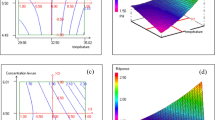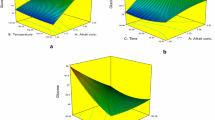Abstract
In the present study, ethanol production from sweet sorghum juice of variety, CSV19SS was optimized using response surface methodology with the help of statistical software Statgraphics Centurian XVI.I. To check storage stability, sweet sorghum juice was stored at 0 and −20 °C and was analyzed for reducing sugars, total acidity, pH and total soluble sugars for a period of 75 days. Sweet sorghum juice was found to be stable under refrigeration conditions for about 75 days without any significant changes in the sugar profile and acidity of the juice. For optimization, effect of three factors i.e. inoculums size, agitation rate and temperature on three response variables i.e. ethanol content, total acidity and pH were studied. The surface plots for desirability and overlay plots were generated to determine the optimum response. Sweet sorghum juice inoculated with Saccharomyces cerevisiae NRRL Y-2034 yielded 8.83 % (v/v) ethanol with fermentation efficiency of 87.33 % under optimized conditions of temperature (30 °C), agitation rate (50 rpm) and inoculum size (7.5 % v/v).












Similar content being viewed by others
References
AOAC 1999. Official methods of analysis 16th edn, 5th Reversion, International, Gaithersburg, Method 942.15.
Bayrock, D.P., and W.M. Ingledew. 2001. Application of multistage continuous fermentation for production of fuel alcohol by very-high-gravity fermentation technology. Journal of Industrial Microbiology and Biotechnology 27(2): 87–93.
Belloch, C., S. Orlic, E. Barrio, and A. Querol. 2008. Fermentative stress adaptation of hybrids within the Saccharomyces sensu strict complex. International Journal of Food Microbiology 22: 188–195.
Belpoggi, F., M. Soffritti, and C. Maltoni. 1995. Methyl tertiary-butyl ether (MTBE)-A gasoline additive-causes testicular and lymphohaematopoetic cancers in rats. Toxicology and Industrial Health 11: 119–149.
Caputi Jr, A., and D. Wright. 1969. Collaboration study of the determination of ethanol in wine by chemical oxidation. Journal of the Association of Official Analytical Chemists 52: 85.
Cassada, D.A., Y. Zhang, D.D. Snow, and R.F. Spalding. 2000. Trace analysis of ethanol, MTBE and related oxygenate compounds in water using solid-phase microextraction and gas chromatography/mass spectrometry. Analytical Chemistry 72: 4654–4658.
Fischer, A., C. Ohem, M. Selle, and P. Werner. 2005. Biotic and abiotic transformations of methyl tertiary-butyl ether (MTBE). Environmental Science and Pollution Research International 12: 381–386.
Jin, H., R. Liu, and Y. He. 2011. Kinetics of batch fermentation for ethanol production with immobilized Saccharomyces cerevisiae growing on sweet sorghum stalk juice. Procedia Environmental Sciences 12: 137–145.
Jones, A.M., K.C. Thomas, and W.M. Ingledew. 1994. Ethanolic fermentation of blackstrap molasses and sugarcane juice using very high gravity technology. Journal of Agriculture and Food Chemistry 42: 1242–1246.
Jovana, A.G., M.D. Jelena, N.D. Sinisa, D.P. Stevan, I.K. Aleksandar, and Z.Z. Zoltan. 2011. Optimization of bioethanol production from intermediates of sugar beet processing by response surface methodology. Biomass and Bioenergy 35: 4290–4296.
Kundiyana, D.K., D.D. Bellmer, R.L. Hunke, M.R. Wilkins, and P.L. Claypool. 2010. Influence of temperature, pH, and yeast on in-field production of ethanol from unsterlized sweet sorghum juice. Biomass and Bioenergy 34: 1481–1486.
Miller, G.L. 1959. Use of dinitrosalicyclic acid reagent for determination of reducing sugars. Analytical Chemistry 31: 426–428.
Rains, G.C., J.S. Cundiff, and G.E. Welbaum. 1993. Sweet sorghum for a piedmont ethanol industry. In New crops, ed. J. Janick, and J.E. Simon. New York: Wiley.
Ratnavathi, C.V., K. Suresh, B.S.V. Kumar, M. Pallavi, V.V. Komala, and N. Seetharama. 2010. Study on genotypic variation on ethanol production from sweet sorghum juice. Biomass and Bioenergy 34: 947–952.
Ronghou, L., and F. Shen. 2008. Impacts of main features on bioethanol fermentation from stalk juice of sweet sorghum by immobilized Saccharomuces cerevisiae (CICC 1308). Bioresource Technology 99: 847–854.
Wu, L., M. Arakane, M. Ike, M. Wada, T. Takai, M. Gau, and K. Tokuyasu. 2011. Low temperature alkali pretreatment for improving enzymatic digestibility of sweet sorghum bagasse for ethanol production. Bioresource Technology 102(7): 4793–4799.
Acknowledgments
The authors acknowledge the contribution of Dr. S. K. Uppal, Deptt. of Chemistry, P.A.U. Ludhiana and Dr. G. S. Kocher, Deptt. of Microbiology, P.A.U. Ludhiana for providing sweet sorghum juice and the yeast cultures respectively used in the present studies.
Author information
Authors and Affiliations
Corresponding author
Rights and permissions
About this article
Cite this article
Phutela, U.G., Kaur, J. Process Optimization for Ethanol Production from Sweet Sorghum Juice Using Saccharomyces cerevisiae Strain NRRL Y-2034 by Response Surface Methodology. Sugar Tech 16, 411–421 (2014). https://doi.org/10.1007/s12355-013-0283-0
Received:
Accepted:
Published:
Issue Date:
DOI: https://doi.org/10.1007/s12355-013-0283-0




